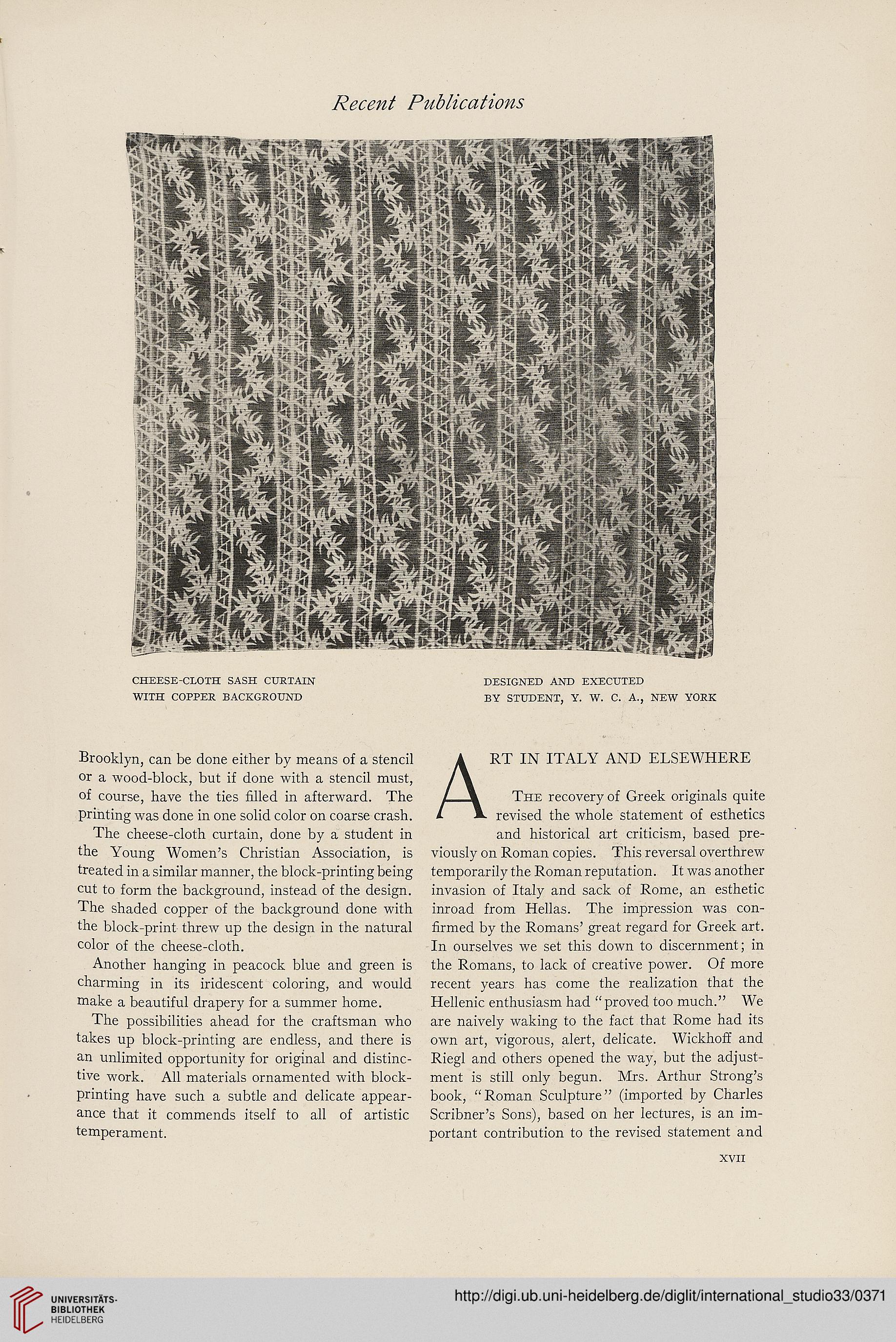Recent Publications
CHEESE-CLOTH SASH CURTAIN DESIGNED AND EXECUTED
WITH COPPER BACKGROUND BY STUDENT, Y. W. C. A., NEW YORK
Brooklyn, can be done either by means of a stencil
or a wood-block, but if done with a stencil must,
of course, have the ties filled in afterward. The
printing was done in one solid color on coarse crash.
The cheese-cloth curtain, done by a student in
the Young Women’s Christian Association, is
treated in a similar manner, the block-printing being
cut to form the background, instead of the design.
The shaded copper of the background done with
the block-print threw up the design in the natural
color of the cheese-cloth.
Another hanging in peacock blue and green is
charming in its iridescent coloring, and would
make a beautiful drapery for a summer home.
The possibilities ahead for the craftsman who
takes up block-printing are endless, and there is
an unlimited opportunity for original and distinc-
tive work. All materials ornamented with block-
printing have such a subtle and delicate appear-
ance that it commends itself to all of artistic
temperament.
ART IN ITALY AND ELSEWHERE
The recovery of Greek originals quite
revised the whole statement of esthetics
and historical art criticism, based pre-
viously on Roman copies. This reversal overthrew
temporarily the Roman reputation. It was another
invasion of Italy and sack of Rome, an esthetic
inroad from Hellas. The impression was con-
firmed by the Romans’ great regard for Greek art.
In ourselves we set this down to discernment; in
the Romans, to lack of creative power. Of more
recent years has come the realization that the
Hellenic enthusiasm had “proved too much.” We
are naively waking to the fact that Rome had its
own art, vigorous, alert, delicate. Wickhoff and
Riegl and others opened the way, but the adjust-
ment is still only begun. Mrs. Arthur Strong’s
book, “Roman Sculpture” (imported by Charles
Scribner’s Sons), based on her lectures, is an im-
portant contribution to the revised statement and
XVII
CHEESE-CLOTH SASH CURTAIN DESIGNED AND EXECUTED
WITH COPPER BACKGROUND BY STUDENT, Y. W. C. A., NEW YORK
Brooklyn, can be done either by means of a stencil
or a wood-block, but if done with a stencil must,
of course, have the ties filled in afterward. The
printing was done in one solid color on coarse crash.
The cheese-cloth curtain, done by a student in
the Young Women’s Christian Association, is
treated in a similar manner, the block-printing being
cut to form the background, instead of the design.
The shaded copper of the background done with
the block-print threw up the design in the natural
color of the cheese-cloth.
Another hanging in peacock blue and green is
charming in its iridescent coloring, and would
make a beautiful drapery for a summer home.
The possibilities ahead for the craftsman who
takes up block-printing are endless, and there is
an unlimited opportunity for original and distinc-
tive work. All materials ornamented with block-
printing have such a subtle and delicate appear-
ance that it commends itself to all of artistic
temperament.
ART IN ITALY AND ELSEWHERE
The recovery of Greek originals quite
revised the whole statement of esthetics
and historical art criticism, based pre-
viously on Roman copies. This reversal overthrew
temporarily the Roman reputation. It was another
invasion of Italy and sack of Rome, an esthetic
inroad from Hellas. The impression was con-
firmed by the Romans’ great regard for Greek art.
In ourselves we set this down to discernment; in
the Romans, to lack of creative power. Of more
recent years has come the realization that the
Hellenic enthusiasm had “proved too much.” We
are naively waking to the fact that Rome had its
own art, vigorous, alert, delicate. Wickhoff and
Riegl and others opened the way, but the adjust-
ment is still only begun. Mrs. Arthur Strong’s
book, “Roman Sculpture” (imported by Charles
Scribner’s Sons), based on her lectures, is an im-
portant contribution to the revised statement and
XVII





